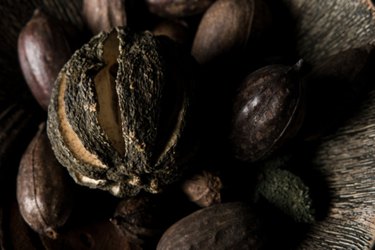Things You'll Need
Large soup pot
Water
Rubber gloves
Cheesecloth
Strainer
Bowl
Bucket
Newspaper
Ladle
Glass jars
Vinegar

Walnuts contain a chemical called juglone, which gives the walnut hull its deep black color. Juglone produces a brown-to-black, colorfast dye resistant to ultraviolet fading, making it an ideal outdoor wood stain. While any walnut variety will produce a stain, the best choice is hulls from the black walnut tree. Identify black walnut trees by their long, compound leaves. The leaves range from 1 to 2 feet long and resemble branches with pairs of leaves evenly spaced along its shaft. Ideally, you should gather walnut hulls while they are still green. Black, shriveled walnut hulls provide the same amount of stain, but require a longer extracting time because the hulls must be rehydrated.
Step 1
Collect 12 to 15 walnut hulls of a single variety.
Video of the Day
Step 2
Rinse the outside of the hulls to remove any dirt or debris.
Step 3
Place the hulls in a large soup pot. The dye will permanently discolor the inside of the pot, so choose a black or older pot. If you want to make an intensely black stain, use a cast iron pot.
Step 4
Fill the pot will enough water to cover the walnut hulls.
Step 5
Bring the water to a boil and then reduce the heat. Simmer the hulls until they are tender.
Step 6
Scrape the hulls away from the nutshell into the stain water. Throw away the nuts.
Step 7
Add enough water to equal the original volume and continue to simmer for another eight to 16 hours. Stir frequently.
Step 8
Line a strainer with at least five layers of cheesecloth. Place the strainer over a bowl or bucket.
Step 9
Cover your work area with two or three layers of newspaper to protect from spills.
Step 10
Ladle the stain over the cheesecloth. Continue until you ladle all of the liquid and hull pulp into the strainer.
Step 11
Gather the cheesecloth and squeeze the liquid from the hull pulp. You can place the pulp in a plastic bag and use again later to make a lighter stain or throw it away.
Step 12
Use the stain immediately or transfer the stain to glass jars for storage.
Step 13
Add 1 tbsp. of vinegar per jar and store the stain for future projects.
Tip
In late summer or early fall, you will find more green walnut hulls. The rest of the year, you will find mostly old, black hulls.
The longer you simmer, the darker the stain will become. If you used black walnut hulls, you will want to use the full 16 hours.
If you just want a light stain for your wood, cut the green hulls in half, pluck out the nut and rub black meat of the hull directly on the wooden surface. Repeat as necessary. This works well for small projects, but may be tiresome for large projects.
Warning
Wear disposable rubber gloves while handling walnut hulls and working with the stain. Solvents will not remove walnut dye from the skin. Instead, the dyed skin will slough off naturally over a period of weeks.
Video of the Day